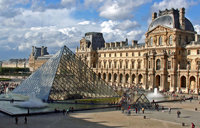 These, in addition to the Capital's 2nd Empire embellishments, did much to make the city itself the attraction it is today.
These, in addition to the Capital's 2nd Empire embellishments, did much to make the city itself the attraction it is today. Paris' museums and monuments are by far its highest-esteemed attractions, and tourist interest has been nothing but a benefit to these; tourism has even motivated both city and State to create new ones. The city's most prized museum, the Louvre, sees over 8 million visitors a year, being by far the world's most visited art museum. Paris' cathedrals are another main attraction: its Notre-Dame cathedral and Basilique du Sacré-Cœur receive 12 million and 8 million visitors respectively. The Eiffel Tower, by far Paris' most famous monument, averages over 6 million visitors per year and more than 200 millions since its construction. Disneyland Resort Paris is a major tourist attraction not only for visitors to Paris, but to Europe as well, with 12.4 million visitors in 2004.

The Louvre is one of the largest and most famous museums, housing many works of art, including the Mona Lisa (La Joconde) and the Venus de Milo statue. Works by Pablo Picasso and Auguste Rodin are found in Musée Picasso and Musée Rodin respectively, while the artistic community of Montparnasse is chronicled at the Musée du Montparnasse. Starkly apparent with its service-pipe exterior, the Centre Georges Pompidou, also known as Beaubourg, houses the Musée National d'Art Moderne. Lastly, art and artefacts from the Middle Ages and Impressionist eras are kept in Musée Cluny and Musée d'Orsay respectively, the former with the prized tapestry cycle The Lady and the Unicorn.
Many of Paris' once-popular local establishments have metamorphised into a parody of French culture, in a form catering to the tastes and expectations of tourist capital. Le Lido, The Moulin Rouge cabaret-dancehall, for example, are a staged dinner theatre spectacle, a dance display that was once but one aspect of the cabaret's former atmosphere. All of the establishment's former social or cultural elements, such as its ballrooms and gardens, are gone today. Much of Paris' hotel, restaurant and night entertainment trades have become heavily dependent on tourism, with results not always positive for Parisian culture.
Map of Paris


Wonderful +++++
ReplyDelete